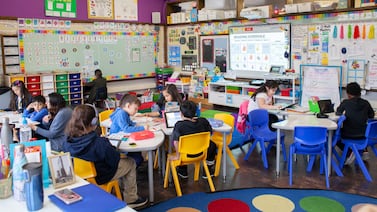Sign up for Chalkbeat Colorado’s free daily newsletter to get the latest reporting from us, plus curated news from other Colorado outlets, delivered to your inbox.
Colorado released school- and district-level results Thursday from PSAT and SAT tests taken by ninth, 10th, and 11th grade students this past spring.
The new data provides a more granular view than the statewide test scores released last week.
Statewide, math results dropped on the ninth and 10th grade PSAT and the 11th grade SAT from last year to this year. For instance, the percentage of 9th graders at or above the state’s college readiness benchmark in math fell to 40% this past spring from 47% in 2023.
This year’s math performance remains far below pre-pandemic levels. State officials cautioned that some of the decrease might be attributed to a new testing format. The SAT was fully online for the first time this spring, and the makeup of the math questions also changed.
Statewide reading and writing results were more mixed, but generally moving in a positive direction. The percentage of 9th and 10th graders meeting the state benchmark rose about 1½ percentage points, while 11th grade results decreased by the same amount.
Tenth grade reading and writing results have now surpassed pre-pandemic levels: 66% of 10th graders met or exceeded the state’s college readiness benchmark this past spring, compared with 64.5% in 2023 and 64.9% in 2019, the last exam before COVID-19 shuttered school buildings.
However, big test score gaps remain between students based on race, family income, and other factors, such as whether students are learning English or have a disability.
Statewide, 11th graders who qualify for free or reduced-price school meals, an indicator of low family income, earned an average combined score of 878 on the SAT, while students who do not qualify for subsidized meals earned an average score of 1041.
The highest combined score a student can earn on the SAT is 1600.
Among school districts with more than 1,000 students that serve a large proportion of students of color, the PSAT and SAT results in the Mapleton, Sheridan, Pueblo City 60, Weld Re-8, and Westminster districts remained below pre-pandemic levels.
Performance in the state’s largest district, Denver Public Schools, also remained below pre-pandemic levels. But unlike most districts in this category, Denver’s results were either flat or trending upwards from last year — with the exception of 9th grade math, which saw a drop.
In other large districts that serve many students of color, some PSAT and SAT results are now higher than they were before the pandemic. In Aurora Public Schools, for example, the reading and writing PSAT performance of both 9th and 10th graders surpassed pre-pandemic levels.
In Harrison School District 2 in Colorado Springs, 11th grade math results were higher this past spring than they were in 2019, as were ninth, 10th, and 11th grade reading and writing results.
Our searchable table below allows you to look up the PSAT and SAT performance for your school and district, and compare it to the statewide averages in both math and reading and writing. The table shows the percentage of tested students who met or exceeded the state’s college readiness benchmark in each subject.
Melanie Asmar is the bureau chief for Chalkbeat Colorado. Contact Melanie at masmar@chalkbeat.org .






